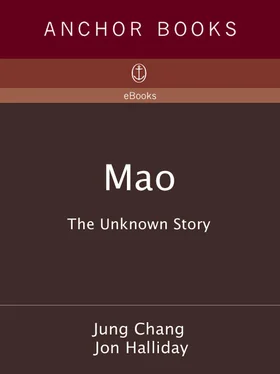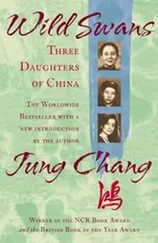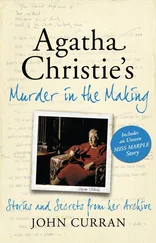In mid-November a messenger arrived in North Shaanxi from Moscow, the first direct liaison for well over a year. He had traveled through the Gobi Desert disguised as a trader wearing a sheepskin coat. In his head he carried codes for resuming radio contact with Moscow, and he brought a radio operator with him. Within a matter of months, the radio link with Moscow was restored, and the person who controlled it at the Chinese end was Mao.
The messenger brought Stalin’s word that the Chinese Reds should “get close to the Soviet Union” by making for the border with Russia’s satellite, Outer Mongolia. The move “to link up with the Soviet Union” could now start.
CHIANG KAI-SHEK WAS less successful in achieving his private agenda. On 18 October, the day the Long March ended for Mao, Chiang saw Soviet ambassador Bogomolov for the first time since just before the March had started. Chiang proposed a “secret military treaty” with Russia. This could only be aimed against Japan, which had stepped up its efforts to detach five provinces from northern China by offering them bogus “independence.” The Russian response was that Chiang must first “regulate relations with the CCP.” The Generalissimo’s close associate and founder of the Chinese FBI, Chen Li-fu, began secret talks straightaway with Bogomolov and Soviet military attaché Lepin on the nuts and bolts of a deal with the CCP — even referring to “cooperation” with the Reds.
During these talks Chen Li-fu asked Bogomolov for the release of Chiang’s son Ching-kuo. Chen told us: “I said to him: We two countries are signing a treaty now, and we are on very good terms. Why do you still detain our leader’s son? Why can’t you release him?” (Loyally, Chen added that he was acting without telling Chiang—“He would not have wanted me to make this request.” This remark reflects the understanding among the few people in on Chiang’s Reds-for-son exchange that the deal must never be attributed to him, or allowed to leak out.)
But Stalin still refused to free his hostage. Ching-kuo had by now been separated from his parents for exactly ten years. In March that year, in his heavy machinery plant in the Urals, love had softened the young man’s bleak life when he married a Russian technician called Faina Vakhreva. In December they were to have their first child, born into the same captivity that Ching-kuo himself would endure for many more moons, as Mao’s fortunes rose, and rose again.
At the time, the lie was told in very vague words to only a few people. Mao later embellished it into a vivid story about how Kuo-tao had sent a cable to his men ordering them to “liquidate” him and the Center. And this became the official version. But Mao did not produce this claim until eighteen months later, on 30 March 1937, when he was trying to purge Kuo-tao. Until then, although there had been a Party resolution denouncing Kuo-tao for “splitting the Red Army,” it did not include this charge. Nor was the accusation mentioned in any of the many subsequent telegrams to Kuo-tao from Mao and his armies. Even Mao’s cable to Moscow denouncing Kuo-tao as soon as radio links were restored in June 1936 did not have a word about it. All this proves that there was no order from Kuo-tao to harm Mao.
There was one small skirmish at a pass called Lazikou, on 17 September. Although this involved only a handful of men, it was later blown up into a major battle — and a major victory. The reason for this fabrication was that, for Mao to validate his split from Kuo-tao, he had to show at least one feat of arms in the period after he broke away from him. In fact, Mao was simply let through at Lazikou.
PART THREE. BUILDING HIS POWER BASE
15. THE TIMELY DEATH OF MAO’S HOST (1935–36 AGE 41–42)
MAO’S HOME for the next decade was the Yellow Earth Plateau in northwest China, near the Yellow River, the second biggest in China after the Yangtze, and the cradle of Chinese civilization. The base had a population of nearly one million, occupying well over 30,000 sq km, mainly in northern Shaanxi, and straddling the border with Gansu province to the west. Far from the country’s heartland, in those days it was the only secure Red territory in the whole of China.
The landscape was dominated by vast stretches of loess, yellow earth, that looked bleak and barren, broken only by long jagged gorges, often hundreds of meters deep, slicing dramatically through the soft substrate formed with the passage of time by minuscule particles of dust blown in from the nearby Gobi Desert. Most of the dwellings were carved into the yellow hillsides. One could gaze far into the distance and often not see a single soul. Wuqi, the first “town” Mao saw on arrival, had only some thirty residents. This area was unique in being relatively underpopulated, and enjoyed something unheard-of elsewhere in China — arable land to spare. Chiang Kai-shek had picked the locality to keep the Red Army alive, but small.
The founder of the base was a local Communist called Liu Chih-tan, who had an army of 5,000 men — more than Mao. For the local Red sympathizers, Chih-tan was a hero. For the Spanish Catholic bishop of the area, whose brand-new cathedral and other properties were seized by Chih-tan’s men in July 1935, he was “daring, and a conspirator in everything that was subversive.”
As Mao approached Chih-tan’s base, he pointedly remarked that Chih-tan’s leadership “does not seem to be correct,” meaning Chih-tan was politically unsound. And it seems that Mao gave secret orders to the Party bureau whose jurisdiction covered Chih-tan’s area (the Northern Bureau) to carry out a purge there. In mid-September Party envoys descended on the base, where they were joined on the 15th by a Red Army unit 3,400 strong which had been driven there from a different part of China. Together, these new arrivals struck out in a savage purge. Although Chih-tan’s forces were superior in strength, he offered no resistance either to the takeover or to the purge. When he was recalled from the front, and discovered on the way that he was going to be arrested, he turned himself in.
The Party envoys condemned Chih-tan for being “consistently right-wing” (newspeak for moderate), and charged him with being an agent of Chiang’s who had “created a Red Army base in order to wipe out the Red Army.” His willingness to submit to Party authority, far from being appreciated as an act of loyalty, was twisted against him, and he was accused of being “cunning, in order to deceive the Party into trusting him.” Hideous torture was applied. A colleague of Chih-tan’s had his right thigh pierced to the bone by a red-hot wire. Many were buried alive. One survivor wrote in 1992: “We were imprisoned in heavy leg-irons … We heard that the pit to bury us alive had already been dug …” Between 200 and 300 people are estimated to have been killed.
It was at this moment that Mao arrived — in time to play the benign arbiter. He ordered arrests and executions to be suspended, and released Chih-tan and his comrades at the end of November. The purge against them was ruled to have been “a serious error.” Two scapegoats were reprimanded.
Mao thus managed both to sabotage the local Red leadership and to present himself as the man who saved them. This put him in a position to take over their base. Thanks to the purge, Chih-tan and his comrades were already sufficiently intimidated by the time Mao turned up (Chih-tan could barely walk after being heavily shackled), and Mao was able to exclude them from decision-making positions and from key military jobs without prompting major resistance. Chih-tan, the founder of the base, was given a lowly post as commander of a detachment titled “the 28th Army,” which was really just a bunch of new recruits, onto whom Mao foisted a trusted man of his own as commissar, and therefore Chih-tan’s boss. Chih-tan did not demur; he endorsed Mao’s authority publicly, and asked his comrades who had been victimized to put the interests of the revolution before their personal sufferings.
Читать дальше










